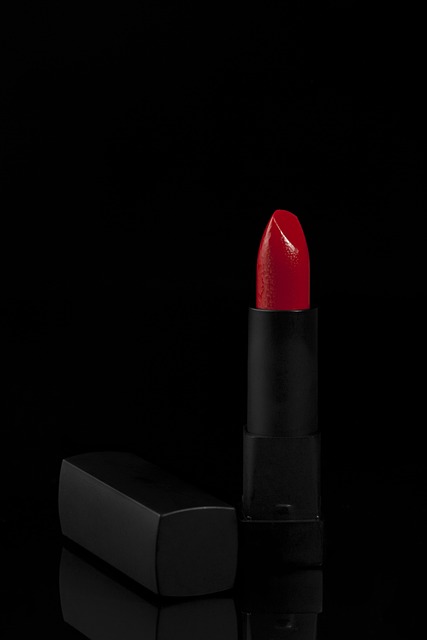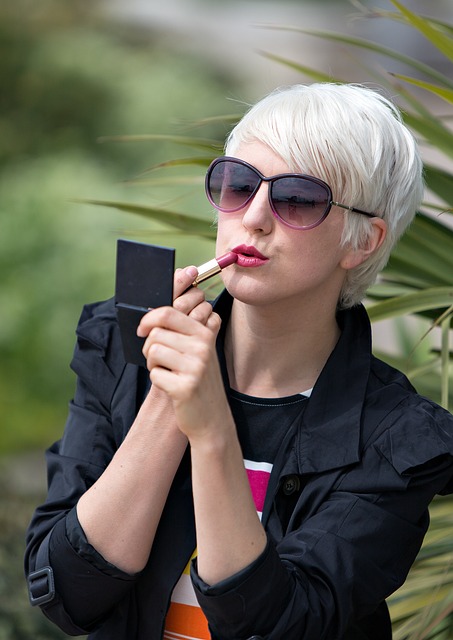Nude lipstick is a multifaceted beauty essential offering a spectrum of shades designed to complement various skin tones. These lipsticks are formulated with moisturizing ingredients such as beeswax, lanolin, and shea butter for hydration and a luxurious feel. The color of nude lipstick is achieved through pigments like iron oxides, titanium dioxide, and mica, which can also provide a subtle shimmer and UV protection. Some formulations may include additional nourishing ingredients like castor oil or vitamin E. The choice between synthetic and natural ingredients in nude lipsticks is significant, with synthetic options offering consistent, vivid colors, while natural ingredients cater to those with sensitive skin or allergies. Nude lipsticks contain a carefully selected blend of chemicals that provide both color and texture, including emollients for moisture and emulsifiers for consistency, all regulated by the FDA to ensure safety and efficacy. Consumers can trust in the rigorous oversight of the cosmetic industry and the clear labeling of ingredients, ensuring they choose nude lipstick products that align with their health and beauty needs.
Exploring the essence of nude lipstick, this article peels back the layers to reveal the scientific composition behind the perfect neutral hue. From the pigments that sculpt its shade to the debate on whether synthetic or natural ingredients make for a safer choice, we delve into the chemicals at play within these beloved cosmetics. We’ll examine common components in nude lipsticks and their roles, as well as the stringent safety and regulatory measures in place to ensure consumer protection. Join us on this enlightening journey through the world of nude lipstick chemistry.
- Unveiling the Composition of Nude Lipstick: A Closer Look at Its Ingredients
- The Role of Pigments and Dyes in Achieving the Perfect Nude Shade
- Synthetic vs. Natural: The Debate Over Lipstick Ingredients
- Common Chemicals Found in Nude Lipsticks and Their Purposes
- Safety and Regulation: Ensuring the Security of Lipstick Chemicals on Consumers
Unveiling the Composition of Nude Lipstick: A Closer Look at Its Ingredients

Nude lipstick, a popular choice for a range of skin tones, often contains pigments that provide a natural or subtle hue on the lips. While the term “nude” suggests a simple, sheer product, the composition of nude lipstick is surprisingly complex. It typically includes emollients like beeswax, lanolin, or shea butter, which are known for their moisturizing properties and contribute to the lipstick’s creamy texture. These components help in hydrating the lips, making nude lipstick a functional makeup choice as well as a cosmetic one. Additionally, nude lipsticks often contain pigments such as iron oxides, titanium dioxide, or mica for their coloring agents. Iron oxides are responsible for the browns and reds that give nude shades depth and warmth. Titanium dioxide can be used to brighten the shade and provide a uniform coverage, while mica imparts a subtle shimmer that enhances the lipstick’s finish. Further, ingredients like castor oil or vitamin E are sometimes included for their nourishing benefits, ensuring that the lips not only look good but also feel well-cared for. The specific blend of these ingredients in nude lipstick varies by brand and formula, each designed to cater to different lip care needs while maintaining the desired color payoff and wearability. Understanding the composition of nude lipstick is crucial for consumers looking for products that are not only aesthetically pleasing but also kind to their skin.
The Role of Pigments and Dyes in Achieving the Perfect Nude Shade

Lipstick, a cosmetic staple for countless individuals, often embodies the perfect blend of functionality and aesthetics. Among the myriad of shades available, nude lipstick stands out for its versatility and ability to complement a wide range of skin tones. The achievement of the ideal nude shade hinges on the precise use of pigments and dyes. These colorants are meticulously selected and blended to create a spectrum of nude shades that can seamlessly adhere to the natural lip tone, enhancing its appearance without overwhelming it.
Pigments used in nude lipsticks are finely milled particles that offer both opacity and sheer coverage depending on the desired effect. The selection of pigments is critical; they must be able to counterbalance the natural color of the lips while imparting a desirable undertone, whether it’s a soft pink, beige, or a more neutral tone. Dyes, on the other hand, are often responsible for introducing more vibrant colors or correcting undertones. They are incorporated in varying concentrations to fine-tune the lipstick’s color profile. The balance between these components is crucial; too much pigment can lead to an unnatural look, while insufficient pigmentation may result in a shade that doesn’t align with the intended nude spectrum. Manufacturers employ advanced techniques and high-quality ingredients to ensure that each nude lipstick delivers the promised color payoff, making it a cherished choice for makeup enthusiasts seeking a natural, flawless look.
Synthetic vs. Natural: The Debate Over Lipstick Ingredients

When considering the spectrum of ingredients in nude lipstick, consumers are often faced with a choice between synthetic and natural components. Synthetic pigments in nude lipsticks offer a wide array of colors that are consistent, long-lasting, and often more vibrant than those derived from natural sources. These synthetics can provide the perfect shade for every skin tone, ensuring that the desired nude hue is achieved with precision. However, there is a growing debate over the potential health implications of synthetic ingredients versus the perceived purity and eco-friendliness of natural alternatives. Proponents of natural lipstick ingredients argue that plant-based pigments can offer a gentler option for those with sensitive skin or allergies. These natural options are often enriched with moisturizing elements like beeswax, shea butter, and vitamin E, which can nourish the lips while providing color. On the other hand, synthetic ingredients like lake dyes, which are inorganic pigments, are known for their stability and durability, making them resistant to fading throughout the day. Consumers must weigh the benefits of both synthetic and natural components when selecting a nude lipstick that aligns with their personal preferences, values, and skin requirements. The decision between synthetic and natural ingredients in nude lipstick is not solely about achieving the perfect shade but also about prioritizing personal health, environmental impact, and ethical considerations.
Common Chemicals Found in Nude Lipsticks and Their Purposes

Nude lipsticks, a staple in many makeup kits, often contain a variety of chemicals that serve specific purposes to achieve both the desired color and the right texture. Among the common ingredients found in nude lipsticks are pigments such as iron oxides and titanium dioxide, which provide the lipstick with its base color and contribute to sun protection by absorbing ultraviolet radiation. These pigments are generally considered safe and are used in a wide range of cosmetic products.
Additionally, nude lipsticks typically include emollients like castor seed oil, shea butter, and beeswax. These components moisturize and soften the lips, giving them a smooth appearance and feel. Emulsifiers, such as cetyl alcohol or stearyl alcohol, are added to ensure that the water-soluble and oil-soluble components of the lipstick remain well blended, maintaining the product’s consistency and longevity on the skin. Preservatives like phenoxyethanol are included to prevent microbial growth and prolong the shelf life of the lipstick. These chemicals, while integral to the formulation of nude lipsticks, are subject to strict regulations by authorities such as the FDA in the United States to ensure safety for consumer use.
Safety and Regulation: Ensuring the Security of Lipstick Chemicals on Consumers

The realm of cosmetics, particularly nude lipstick, has long been a subject of interest for consumers and regulators alike. Ensuring the safety of the chemicals used in these products is paramount to maintaining consumer trust and health. The U.S. Food and Drug Administration (FDA) oversees the ingredients and manufacturing processes of cosmetics, including lipstick, ensuring that they are safe for use. The FDA’s oversight includes a rigorous review of color additives and other components, such as preservatives and emollients, which are integral to the texture and longevity of nude lipsticks. These substances undergo stringent tests to assess their potential effects on human health.
Moreover, consumer advocacy groups play a crucial role in monitoring the cosmetic industry’s adherence to safety standards. They conduct their own research and publish findings that can lead to further regulatory actions or improvements in manufacturing practices. The transparency of ingredient lists allows consumers to make informed choices, with nude lipstick options free from harmful substances. This commitment to safety and regulation is a testament to the industry’s dedication to consumer well-being, ensuring that the chemicals in lipstick remain a cause for concern only among those who question their necessity rather than their safety.
In conclusion, the exploration into the composition of nude lipstick reveals a complex interplay between pigments, dyes, and various chemicals that contribute to its desirable hues and textures. The debate between synthetic and natural ingredients in lipstick products is ongoing, with consumer preferences playing a pivotal role in shaping industry standards. It’s crucial for manufacturers to adhere to safety and regulatory measures to ensure the substances used are secure for application. Understanding the common chemicals found in nude lipsticks, such as those that impart color, enhance texture, and improve longevity, allows consumers to make informed decisions. Ultimately, the choice between synthetic and natural nude lipstick options should align with personal values and preferences, ensuring a safe and satisfying experience for those embracing this iconic beauty staple.
